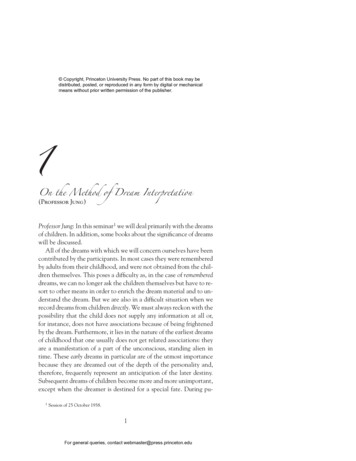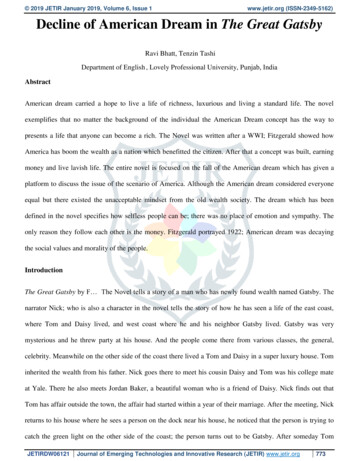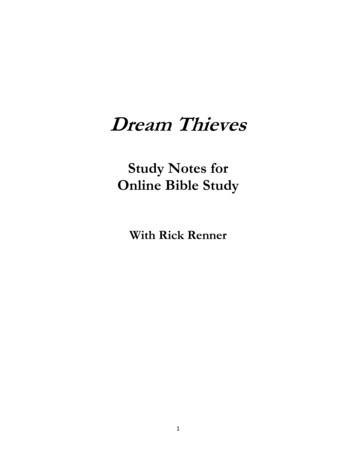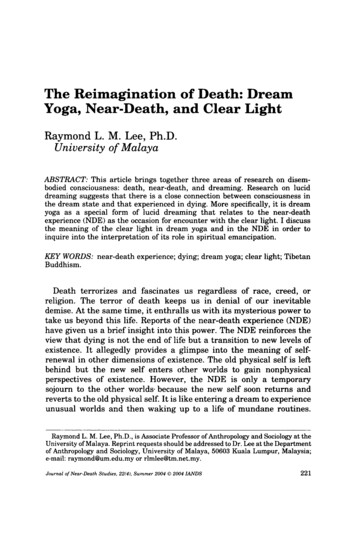
Transcription
Copyright, Princeton University Press. No part of this book may bedistributed, posted, or reproduced in any form by digital or mechanicalmeans without prior written permission of the publisher.1On the Method of Dream Interpretation(Professor Jung)Professor Jung: In this seminar1 we will deal primarily with the dreamsof children. In addition, some books about the significance of dreamswill be discussed.All of the dreams with which we will concern ourselves have beencontributed by the participants. In most cases they were rememberedby adults from their childhood, and were not obtained from the chil dren themselves. This poses a difficulty as, in the case of remembereddreams, we can no longer ask the children themselves but have to re sort to other means in order to enrich the dream material and to un derstand the dream. But we are also in a difficult situation when werecord dreams from children directly. We must always reckon with thepossibility that the child does not supply any information at all or,for instance, does not have associations because of being frightenedby the dream. Furthermore, it lies in the nature of the earliest dreamsof childhood that one usually does not get related associations: theyare a manifestation of a part of the unconscious, standing alien intime. These early dreams in particular are of the utmost importancebecause they are dreamed out of the depth of the personality and,therefore, frequently represent an anticipation of the later destiny.Subsequent dreams of children become more and more unimportant,except when the dreamer is destined for a special fate. During pu 1Session of 25 October 1938.1For general queries, contact webmaster@press.princeton.edu
Copyright, Princeton University Press. No part of this book may bedistributed, posted, or reproduced in any form by digital or mechanicalmeans without prior written permission of the publisher.SEMINAR 1berty and until the twentieth year, dreams become more importantagain, then they lose importance, and finally they carry more andmore weight again after the thirty-fifth year. This does not apply toall persons, but to the majority of cases. I would like to ask you tosearch your own memory if you can still remember the first dream ofyour life. Many remember dreams from their fourth year, others evenfrom the third year. Maybe you could also ask your acquaintances andfriends if they remember their first dreams. You should then also notewhat you know about the later lives of the dreamers, and also whatyou know about their families—if you know them—and whetheryou happened to notice any peculiarities among these.Before starting our discussion of the individual dreams, I wouldlike to make a few remarks on the method of dream interpretation.As you know, the dream is a natural phenomenon. It does notspring from a special intention. One cannot explain it with a psy chology taken from consciousness. We are dealing with a particularway of functioning independent of the human ego’s will and wishes,intention or aim. It is an unintentional occurrence, just like every thing occurring in nature. So we also cannot assume that the sky getsclouded only to annoy us; it simply is as it is. The difficulty is, how ever, to get a handle on that natural occurrence.It seems best to be as unprejudiced as possible when we let thingsinfluence us. Yet anything we have to say about the event is still ourinterpretation. We are in the same situation as any natural scientist,who also deals with phenomena that do not reveal their meaning andconformity with a natural law. Any meaning given to what happenscomes from us. We are facing the difficult task of translating naturalprocesses into psychical language. To this end we have to use auxil iary and approximate terms for want of others, and make hypothe ses. . . . But there always remains the doubt whether we have trulysucceeded in giving a picture of what happens. One could, of course,argue that all of this has no meaning at all. If anything is subjectiveanyway, then one could as well say that nature does not conform tolaws, that there is chaos. It is, however, a question of temperamentwhether to assume a meaning, even if one may not understand it yet,or to prefer saying: “All of this has no meaning anyway.” But one can2For general queries, contact webmaster@press.princeton.edu
Copyright, Princeton University Press. No part of this book may bedistributed, posted, or reproduced in any form by digital or mechanicalmeans without prior written permission of the publisher.ON THE METHOD OF DREAM INTERPRETATIONalso be of the opinion that, although each interpretation may alwaysbe a human assumption about what is happening, one can still try tofind out the truth about it. Yet we can never be sure to achieve thataim. This uncertainty can partly be overcome, however, by insertinga meaning into other equations and then checking whether the re sults of these equations are in accordance with that meaning. We canthus make an assumption about the meaning of one dream, and thensee whether this attribution of a meaning also explains another one,that is, if it is of more general significance. We can also make controltests with the help of dream series. I would actually prefer to dealwith children’s dreams in dream series because when we investigatedreams in series, we most often find confirmation or corrections ofour original assumptions in the following dreams. In dream series, thedreams are connected to one another in a meaningful way, as if theytried to give expression to a central content from ever-varying an gles. To touch this central core is to find the key to the explanationof the individual dreams. It is not always so easy, however, to delimita dream series. It is a kind of monologue taking place under the coverof consciousness. This monologue is heard, so to speak, in the dream,and sinks down during the periods when we are awake. But in a waythe monologue never ends. We are quite probably dreaming all thetime, but consciousness makes so much noise that we no longer hearthe dream when awake. If we succeeded in making a complete list [ofthe unconscious processes], we could see that the whole describes acertain line. It is a very difficult task when done thoroughly.The way we explain dreams is primarily a causal one. We are in clined to explain nature in such a way. Here this method meets enor mous difficulties, however, because we can explain in a strictly causalway only when the necessity of a correlation between cause and ef fect can be proven. But this clear relation can be found, above all, inso-called inanimate nature. Whenever phenomena can be isolatedand subjected to experiments, when, in other words, uniform condi tions can be established, strict attributions of cause and effect can bemade. In the case of biological phenomena, however, we are hardlyable to ascertain a disposition that would lead, of necessity, to cer tain effects. For here we are facing such complex material, such a di 3For general queries, contact webmaster@press.princeton.edu
Copyright, Princeton University Press. No part of this book may bedistributed, posted, or reproduced in any form by digital or mechanicalmeans without prior written permission of the publisher.SEMINAR 1versity and complexity of conditions, that no unequivocal causal con nections can be maintained. Here the term conditional is much moreappropriate, that is, such and such conditions can lead to such andsuch effects. It is an attempt to replace strict causality with an inter woven action of conditions, to extend the unequivocal connectionbetween cause and effect with a connection open to many interpre tations. Thus causality as such is not abolished, but only adapted tothe multilayered material of life. We have to take into account thatthe psyche, like all biological phenomena, is of a goal-oriented, pur posive nature. This does not at all contradict the previously men tioned opinion that the dream is something unintentional. There welaid stress on the fact that natural phenomena occur unconsciously,independent of consciousness. This does not preclude the develop ing forms of the psyche from being determined by unconscious purpo siveness. We cannot but assume that the fundamental nature has al ways been there already, and that everything that occurs is only apurposive unfolding of this primal disposition. Even things that seemto be completely unpurposive in the psychical or biological fields canbe examined as to their possible purposiveness. Ancient medicine,for instance, thought that fever is, in all circumstances, a symptomof illness to be fought against. Modern medicine knows that it is acomplicated and purposive defense phenomenon, and not the noxathat causes the illness. In working with dreams, too, we have alwaysto keep in mind this aspect of inner purposiveness of what is hap pening. In this sense, we may talk about the unconscious goal orienta tion of the dream process, in noting that these are not conscious goals,not intentions like those of consciousness, but purposive automa tisms that, like cell reactions, cannot be other than purposive.bbbThe dream is no unequivocal phenomenon. There are several possi bilities of giving a meaning to a dream. I would like to suggest to youfour definitions, which are more or less an extract of the variousmeanings I have come across that dreams can have.1. The dream is the unconscious reaction to a conscious situation. Acertain conscious situation is followed by a reaction of the uncon 4For general queries, contact webmaster@press.princeton.edu
Copyright, Princeton University Press. No part of this book may bedistributed, posted, or reproduced in any form by digital or mechanicalmeans without prior written permission of the publisher.ON THE METHOD OF DREAM INTERPRETATIONscious in the form of a dream, whose elements point clearly,whether in a complementary or a compensatory way, to the im pression received during the day. It is immediately obvious thatthis dream would never have come into being without the partic ular impression of the previous day.2. The dream depicts a situation that originated in a conflict betweenconsciousness and the unconscious. In this case, there is no con scious situation that would have provoked, more or less withoutdoubt, a particular dream, but here we are dealing with a certainspontaneity of the unconscious. To a certain conscious situationthe unconscious adds another one, which is so different from theconscious situation that a conflict between them arises.3. The dream represents that tendency of the unconscious that aimsat a change of the conscious attitude. In this case, the counterpositionraised by the unconscious is stronger than the conscious position:the dream represents a gradient from the unconscious to con sciousness. These are very significant dreams. Someone with a cer tain attitude can be completely changed by them.4. The dream depicts unconscious processes showing no relation tothe conscious situation. Dreams of this kind are very strange andoften very hard to interpret because of their peculiar character.The dreamer is then exceedingly astonished at why he is dreamingthis, because not even a conditional connection can be made out.It is a spontaneous product of the unconscious, which carries thewhole activity and weight of the meaning. These are dreams of anoverwhelming nature. They are the ones called “great dreams” bythe primitives. They are like an oracle, “somnia a deo missa.”2They are experienced as illumination.Dreams of this last kind also appear before the breakout of mentalillness or of severe neuroses, in which suddenly a content breaksthrough by which the dreamer is deeply impressed, even if he doesnot understand it. I remember such a case from before the [First]World War:2Latin: “Dreams sent by God” (ed.).5For general queries, contact webmaster@press.princeton.edu
Copyright, Princeton University Press. No part of this book may bedistributed, posted, or reproduced in any form by digital or mechanicalmeans without prior written permission of the publisher.SEMINAR 1I was visited by an old man, a professor of canon law at a Catholicuniversity. He made a dignified impression, like the old Mommsen.3He had business to do with me and, when this had been dealt with,said to me, “I have heard that you are also interested in dreams?” Itold him, “This is part of my business.” I sensed that his soul was con sumed by a dream, which he then actually recounted. He had hadthis dream many years before, and it preoccupied him again andagain.He is on a mountain-pass road, winding along a precipice. Below there is acanyon. The road is secured against the canyon by a wall. The wall ismade of Parian marble4 with its antique yellowish tinge, as he notices atonce. At this moment he sees a strange figure dancing downward on thewall, a naked woman with the legs of a chamois, a “fauna.” She thenjumps down into the precipice and disappears. Then he awakens.This dream preoccupied him immensely. He had already told it tomany people.bbbAnother dream is from a thirty-year-old man, who consulted me be cause of neurasthenia, which had set in quite suddenly; he had beena prince’s tutor and had had a nervous breakdown in this hard duty. Iwas intrigued by the fact that this neurasthenia—usually alreadypresent before in these cases, and then only getting worse overtime—should have set in so suddenly. I asked him what happened atthe time when he got the vertigo and the pains. At first he said thatnothing special had occurred. I asked him about his dreams duringthat period. Then it surfaced that he had had a strange dream,whereupon the illness broke out.He is going for a walk on a dune and suddenly discovers black shards onthe ground. He lifts them; they are prehistoric pieces. He goes home,3Theodor Mommsen (1817–1903), influential German historian and jurist, winner of theNobel Prize for Literature in 1902, and author of Römische Geschichte [Roman History] andRömisches Staatsrecht [Roman Constitutional Law] (ed. and trans.).4Páros, island in the Aegean Sea, famous in ancient Greece for its semitransparent mar ble used for sculpture (trans.).6For general queries, contact webmaster@press.princeton.edu
Copyright, Princeton University Press. No part of this book may bedistributed, posted, or reproduced in any form by digital or mechanicalmeans without prior written permission of the publisher.ON THE METHOD OF DREAM INTERPRETATIONfetches a spade, begins to dig up the ground, and discovers a whole prehis toric settlement, weapons and tools, stone axes, and so on. He is im mensely fascinated and awakens sweating with excitement.The dream recurred, and then the patient broke down. He was ayoung Swiss.In psychotherapeutic treatment, certain elements can appear al ready weeks or months or years earlier, not yet connected at all toconsciousness; these are direct products of the unconscious.As you notice, I differentiate dream processes according to howthe reactions of the unconscious stand in relation to the conscioussituation. One can detect the most various transitions, from a reac tion of the unconscious determined by the elements of conscious ness, to a spontaneous manifestation of the unconscious. In the lat ter case, the unconscious proves to be a creative activity, in which itlets contents ascend into consciousness that have not yet been pres ent there.One usually assumes that the content of the dream stands in rela tion to consciousness, assuming that, for instance, conscious psychi cal contents are associatively linked to unconscious ones. This iswhat gave rise to the theory that the dream has to be explained solelyout of consciousness, and that the unconscious as such is a derivativeof consciousness. But this is not so; actually, the exact opposite is thecase: the unconscious is older than consciousness. Primitive man lives toa great extent in unconsciousness, and we too, by the way, spend athird of our lives in the unconscious: we dream or doze. The uncon scious is what is originally given, from which consciousness risesanew again and again. Consciousness, being conscious,5 is work thatexhausts us. One is able to concentrate only for a relatively shorttime, therefore, only to fall back into the unconscious state again;one lapses into dreams or unintentional associating. It is, in Faust’swords: “Formation, Transformation, / Eternal minds in eternal recre ation.”6 Thus there are dreams in whose contents no relation to con 5In the original: Bewußt-Sein, a play on “consciousness” (Bewußtsein) and “being con scious” (bewußt sein) (trans.).6Goethe, Faust 2, lines 6287–88 (trans.).7For general queries, contact webmaster@press.princeton.edu
Copyright, Princeton University Press. No part of this book may bedistributed, posted, or reproduced in any form by digital or mechanicalmeans without prior written permission of the publisher.SEMINAR 1sciousness can be detected, and whose whole activity is located in theunconscious. Everything—the motive of the dream and its activ ity—springs from the unconscious and cannot be derived from con sciousness. When you want to “force” such a dream and make it intoa derivative of consciousness, you simply violate the dreaming of thedream, resulting in complete nonsense.Dream processes follow from several causes and conditions. Thereare about five different possible sources:1. They can stem from somatic sources: bodily perceptions, states ofillness, or uncomfortable body postures. They can be bodily phe nomena that, for their part, are caused themselves by quite un conscious psychical processes. The ancient dream interpretersmade a great deal of the somatic source of stimuli, and this expla nation is still frequently found today. Experimental psychology stilltakes the view that dreams always have to originate in somethingsomatic. This is the well-known view of the dream: one ate toomuch before going to bed, lay on one’s back or on one’s belly, andtherefore had that dream.2. Other physical stimuli, not from one’s own body but from the envi ronment, can have effects on the dream: sounds, stimuli from light,coldness, or warmth.I would like to give you an example from the French literature:Someone is dreaming: He is in the French Revolution. He is persecutedand finally guillotined. He awakes when the blade is sliding down. This iswhen a part of the frame of the canopy fell on his neck. So he musthave dreamed the whole dream at the moment when the framewent down.Examples of this kind have often led to the opinion that such adream, in which one has a clear sense of time, takes place in a veryshort time-span.I remember, for instance, such a dream from my own adolescence.As a university student I had to get up at half past five in the morn ing, because the botany lecture started at seven o’clock. This was8For general queries, contact webmaster@press.princeton.edu
Copyright, Princeton University Press. No part of this book may bedistributed, posted, or reproduced in any form by digital or mechanicalmeans without prior written permission of the publisher.ON THE METHOD OF DREAM INTERPRETATIONvery tough for me. I always had to be awakened; the maid had topound at the door until I finally woke up. So, once I had a verydetailed dream.“I was reading the newspaper. It said that a certain tension between Swit zerland and foreign countries had arisen. Then many people came and dis cussed the political situation; then there came another newspaper, andagain it contained new telegrams and new articles. Many people got ex cited. Again there were discussions and scenes in the streets, and eventu ally mobilization: soldiers, artillery. Canons were fired—now the war hadbroken out”—but it was the knocking on the door. I had the clear im pression that the dream had lasted for a very long time and come to aclimax with the knocking.As evidence for the view that dreams have no temporal dimensionbut take place only at the moment of the acoustic stimulus, it mightbe helpful to quote the extremely complex perceptions of a person atthe moment of a fall.During the few seconds of his fall in the mountains, the well-knownSwiss geologist Heim7 saw his whole life in review.The same is told in the story of a French admiral. He fell into thewater and nearly drowned. In this short moment, the images of hiswhole life passed before his eyes.It has to be stressed, however, that such moments are of an immenseintensity. You can have an overall view in them that is not successiveat all. During sleep there is no such intensity. That is the problem.That is why such cases give no explanation for the lack of a tempo ral dimension in dreams.To be frank, I always think of another possibility, which is of courseequally quixotic: that there is something going on in the realm of theunconscious with the notion of time, that time comes apart a little inthe unconscious, that is, the unconscious always remains beside thepassing of time and perceives things that do not yet exist. In the un 7Albert Heim (1849–1937), Swiss geologist, known for his studies of the Swiss Alps, andprofessor at the University of Zurich (ed. and trans.).9For general queries, contact webmaster@press.princeton.edu
Copyright, Princeton University Press. No part of this book may bedistributed, posted, or reproduced in any form by digital or mechanicalmeans without prior written permission of the publisher.SEMINAR 1conscious, everything is already there from the beginning. So, for ex ample, one often dreams of a motif that plays a role only the next dayor even later. The unconscious does not care about our time or thecausal interrelation of things. This can also be observed in dream se ries. The series does not form a chronological, consecutive order inthe sense of our temporal order. That is why it is so difficult to tellwhat comes first and what later. If one tried to characterize the na ture of dreams, one could say that they do not form a chronologicalseries as in a b c d, with b following from a, and c from b. We ratherhave to suppose an unrecognizable center from which the dreams em anate. This idea can be illustrated as in the figure.Because dreams enter into consciousness one after the other, weconceive them with the help of the temporal category and relatethem to one another in a causal way. It cannot be excluded, however,that the true order of the first dream enters into consciousness onlymuch later. The seemingly chronological series is, as it were, not thetrue series. If we conceive of it this way, we make a concession to ourconcept of time. There are dream sequels into which another motifsuddenly inserts itself, only to be left later to make room for an ear lier motif. The actual arrangement of dreams is a radial one: thedreams radiate from a center, and are only later subjected to the in fluence of our time. In the final analysis, they are arranged around acenter of meaning.In the unconscious we have, after all, to reckon with other cate gories than in consciousness; this is similar to quantum physics,where facts are altered by the act of observation, as, for example, inthe observation of the atomic nucleus. It seems that difficult lawsapply in the microphysical world of the atom than in the macrophysical world. In this respect, there is a certain parallelism between10For general queries, contact webmaster@press.princeton.edu
Copyright, Princeton University Press. No part of this book may bedistributed, posted, or reproduced in any form by digital or mechanicalmeans without prior written permission of the publisher.ON THE METHOD OF DREAM INTERPRETATIONthe unconscious and the microphysical world. The unconsciouscould be compared to the atomic nucleus.In everyday life, too, it can be observed how the unconscious an ticipates things. Often these are quite harmless things without any fur ther importance, as for instance the following phenomena: you walkon the street and believe you see an acquaintance. It is not he, butlater he does come by. Such strange “near-miss perceptions” are veryfrequent. But they are so insignificant and carry so little weight thatone usually overlooks them, thinking, “Such a coincidence!” Butthere are also quite fabulous examples.I have experienced such an example with a friend at the university.He was a natural scientist. His father had promised him a trip toSpain if he did well on an exam. Right before the exam he had adream that he told me on the spot.He is in a Spanish town and follows a street to a square into which severalstreets lead, and which is defined by a cathedral. He strolls across thesquare and turns right, as he first wants to have a look at the cathedralfrom the side. As he is turning into that street, a carriage with two Isabellahorses is coming. Then he wakes up.The dream made such an impression on him, he told me, because theimage was of such great beauty and brilliance.Three weeks later, after his exam, he traveled to Spain. Fromthere I received the news that the dream had come true. In a Spanishtown he came to such a square. At once he remembered the dream,and said to himself: “Now, if the horses in the side street also cametrue!” He went into the side street—and the horses were there! Hewas an absolutely reliable man, is now in a position in the civil ser vice, and was otherwise never known for such things but, on thecontrary, for his proverbial dryness and sobriety. I have not heardanything similar from him again.This case is not exceptional. There are numerous experiences of thiskind. When you treat many patients with neuroses, you can fre quently make such observations; over time you realize their typical11For general queries, contact webmaster@press.princeton.edu
Copyright, Princeton University Press. No part of this book may bedistributed, posted, or reproduced in any form by digital or mechanicalmeans without prior written permission of the publisher.SEMINAR 1character and can alert people beforehand that something will hap pen. In these cases I usually say, “Attention now, something’s goingto happen!” The following dream is an example:A female patient of middle age. For some time, her dreams dealt witha certain problem. Suddenly there comes a dream, with no connec tion to anything else:She was alone in a house. Evening fell. She went through the house toclose all windows. Then she remembered a back door that she also had tolock. She went to the door and saw that it had no lock. She wondered whatto do and started to look for pieces of furniture or boxes to put in front ofthe door. While she was doing this, it grew ever darker, ever more un canny. All of a sudden the door flew open, and in shot a black bullet, rightinto the middle of her body. She woke up with a scream.8It was the house of an aunt living in America. She had been thereonce, twenty years earlier. After a quarrel, the family was completelytorn apart, and with this aunt in particular she was on absolutely badterms. She had not seen her for twenty years nor kept in touch withher at all. She did not know if that aunt still lived in that house or,for that matter, if she was still alive. I inquired of the patient’s sisterabout the correctness of this information, and she corroborated it. Itold the patient to write up this dream and its date. Three weeks latera letter arrived from America saying that this aunt had died. And shehad died on the very day on which the patient had had that dream.This is a typical dream.Such effects—of whatever kind—often have the character ofshots. I remind you of the famous “witches’ shot.”9 The same ideascan be found among the North American Indians: the medicine mancan “shoot” you with something—for example, a so-called icicle—to make you ill. Similar ideas are found in an English book about themystic Anna Kingsford.10 She believed that she had the same capa 8Jung quoted this dream also in his review of the work of Macrobius; see volume 2 of theEnglish edition (ed.).9 Hexenschuß literally, “witch’s shot”; a sudden onset of lumbago (trans.).10Edward Maitland, Anna Kingsford: Her Life, Letters, Diary and Work.12For general queries, contact webmaster@press.princeton.edu
Copyright, Princeton University Press. No part of this book may bedistributed, posted, or reproduced in any form by digital or mechanicalmeans without prior written permission of the publisher.ON THE METHOD OF DREAM INTERPRETATIONbilities and would be able to achieve such effects. The yogis in Tibetare said to be able to exert evil influence on others.11 What they sendout is of an oblong shape. It is beyond our knowledge what is at workhere, but the consensus gentium speaks of it.12 The Tibetans certainlyknow nothing about English literature, nor my patient anythingabout Tibet. But there must exist a common source for this assump tion, and it must lie in a peculiar psychical factor that we cannot ex plain for the time being. I am all against superciliously ascending thethrone of scepticism and declaring it a swindle. What interests me isthat everywhere these things are said to be so. This idea is as com mon and widespread as, for instance, the one that the dead do notknow they are dead, and have to be enlightened about it to find rest.Independent of one another, these ideas are found among spiritual ists and primitives, and in Tibetan texts. In the Bardo Thödol you findan instruction concerning how to enlighten the dead person that heis really dead.13 The interesting question here is: How can this be ex plained? Which primal factors are in existence here to which thesestatements refer?3. Now there are not only physical events that cause dreams, but alsopsychical ones. It happens that certain psychical occurrences in theenvironment are perceived by the unconscious.In my collection of dreams there is a case in which a child betweenthe ages of three and four dreams that two angels are coming, arepicking up something from the ground, and are sending it
method of dream interpretation. As you know, the dream is a natural phenomenon. It does not spring from a special intention. One cannot explain it with a psy chology taken from . consciousness. We are dealing with a particular way of functioning independent of the human ego’s will and wishes, intention or aim.File Size: 691KB









![Requiem For The American Dream [Transcript]](/img/13/requiem-for-the-american-dream-transcript.jpg)
